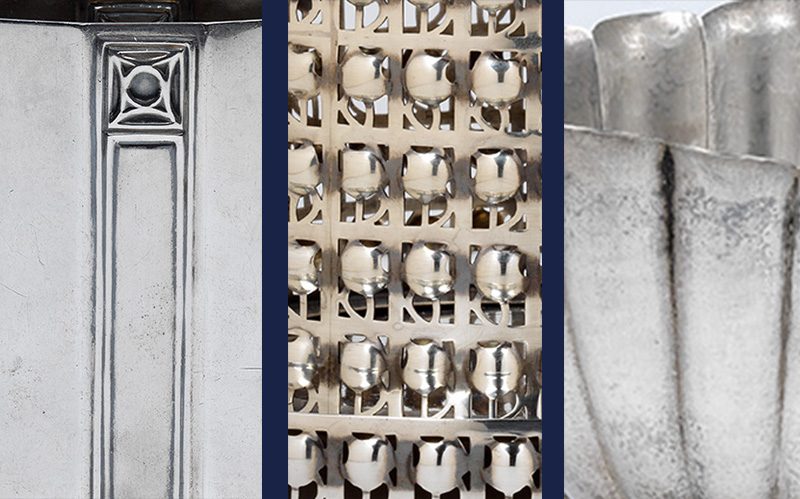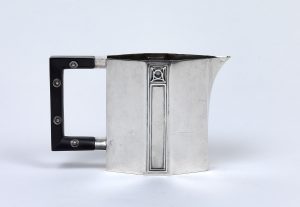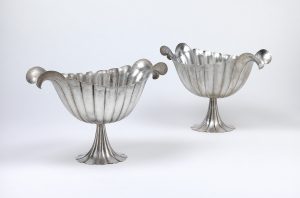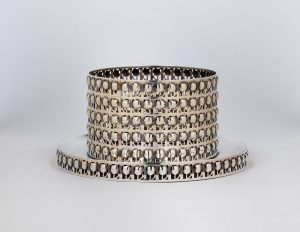
3 objects, 3 styles, many paths
Josef Hoffmann is regarded as a pioneer of modernism. He pursued a creative path that was to become seminal: exemplary, varied and individual, with a sense of tradition. Three objects in the upcoming Art Nouveau auction show how Hoffmann found his path.
by Magda Pfabigan
1

“Do you believe in the ornament?“
This was probably the crucial question in the fin-de-siècle art discourse: the Kunstwollen (“will to art”) of Art Nouveau had found its answer: everything had to be an inventive flight of fancy, while at the same time adorning the object.
This postulate had long been embraced by the Scottish and English art world where, in the last third of the 19th century, a new type of line art had crystallized around the “Guild of Handicraft”, the “Arts and Crafts Movement” and the “Glasgow School of Art.” Charles Rennie Mackintosh and Margaret MacDonald’s experimentation with plain “lines” and their abundant features won international recognition and hit a new peak in terms of geometry and strictness with the Vienna Secession and Wiener Werkstätte.
Created by Josef Hoffmann in 1904/05, the cream jug in the upcoming Art Nouveau auction also bears these modern features. In recent years the masterpiece has been presented at important exhibitions of the Wiener Werkstätte and – most recently – at the MAK Museum of Applied Arts, but it also fulfils the requirement of Charles Ashbee and the “Guild of Handicraft,” according to which every object should show that its creator made the greatest use of their technical and artistic skills. An early observer discovered the effect of “the right kind of superb purity” in the works of Ashbee and Hoffmann:
“This is to say that he knows when to keep still, to hold back when a wide arc of unornamented surface increases the beauty of the object.” (“The Studio”, 1896/97)
The year is 1909 –
– i.e. the year after the brilliant “Kunstschau”, the exhibition that aimed for art to penetrate all areas of life. The entire exhibition building was designed by Josef Hoffmann and even dedicated an individual room to the Wiener Werkstätte. Hermann Muthesius commented, with some justification: “At first glance one might think that the entire exhibition was made by Hoffmann and Moser.” (“Wiener Allgemeine Zeitung,” 19 September 1908)
The “Kunstschau” was remarkable not just for the great variety of objects – which was due to the fact that young artists had joined the Hoffmann school – but also for its stylistic reorientation. As Kolo Moser worked less and less for the Wiener Werkstätte and finally left, the workshop turned its back on “pure geometry” and its objects became more decorative and floral. The “bumpy ivy” décor of our caviar dish is a beautiful illustration of this new tendency.
3

It is once again a parting
In 1923 – it was once again a parting that caused Hoffmann’s style to change, when the death of 36-year-old Dagobert Peche put an end to their prolific collaboration. Hoffmann wrote:
“Not even every hundred years, at most perhaps every three hundred years, does a country see the birth of such a genius. Dagobert Peche was the greatest ornamental genius Austria has produced since the Baroque. It was incredible to see the grace and imagination, always purified by the greatest skill, that made Dagobert Peche the guiding master in all areas of the decorative.”
(circular from 13 June 1923)
But the greatest way in which Hoffmann honoured the deceased was not by praising him in eulogy, but by adapting, continuing and adopting stylistic elements from Peche’s art – and thus contributing to his immortality. Designed by Hoffmann before 1925, our two centrepieces provide excellent proof of this hypothesis.
Magda Pfabigan is Art Nouveau and Art Déco specialist at Dorotheum.
AUCTION
Art Nouveau, 20th Century Arts and Crafts
4 December 2017, 4 pm
Palais Dorotheum Vienna














